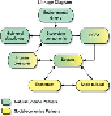Geoscience Reference
In-Depth Information
Figure 7.1
ODEMM linkage framework
Both the MCZ framework developed in Hussain
et al
. (
2010
) (i.e. direct link from a subset
of ecological characteristics to services) and the more complex ODEMM linkage frame-
work are valid and fit for purpose, and both allow environmental economic valuation to be
applied in that the unit of account is changes in ecosystem service provisioning. A similar
approach would likely be applicable in most ecosystem service-based evaluations of man-
agement measures.
7.3.2.3 Biophysical impact scoring
binations of marine habitat/ecosystem service. Since the exact location of the MCZ study
sites was not known and the networks developed in Richardson
et al
. (
2006
) were only
indicative, the evaluation methodology used was generic, in the sense that the ecosystem
provisioning of a 'typical' hectare of a habitat type (e.g. aphotic reef) was estimated under
BAU and MCZ applications.
Oneofthecriticalissuesinanybio-economicassessmentistosetupamethodological
framework that considers only
marginal
changes, and thus cross-refers the with-policy
scenario with BAU. For the MCZ case study, the time horizon was 20 years from policy
inception and as such, an assessment of what would happen under BAU for each habitat/
service combination was required. Any extant conservation measures that would have an
impact during the 20-year study period are included in BAU; these included three statutory
marine nature reserves, 76 Special Areas of Conservation (for marine habitats and species),
and 72 Special Protection Areas (marine habitats for birds) in the UK. Further, any predict-

